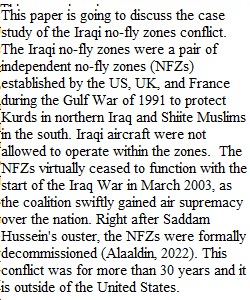


Q Assignment 2: Conflict Resolution, Cooperation in the Middle East - Final Paper (Individual – 30 points): This is an individual (not group) project. Find a case of a conflict that ended in cooperation, agreement(s), resolutions, peacebuilding, or a peace treaty between two socially distinct groups (e.g., ethnic, or religious groups) outside the US that had a protracted conflict (10+ years). Please note that while injustices are often part of conflict, the case needs to include two separate parties with different group identities (preferably two different states or nations) who are in conflict. Be sure to submit your paper topic and source list before you begin writing the paper, and present a 1-3 slide poster/presentation of your project to a group of your peers in class. For paper 2, follow the following guidelines (you can also use the template below): • CASE DESCRIPTION: Provide background and context on the conflict and the main relevant events, and then move to describe what the agreement/cooperation contained, for the case study description, use at least two, and preferably more, sources from news articles, academic journals, or books/book chapters. Make sure your sources are approved by the lecturer first. Experience with past papers has shown that papers that included more sources were usually more coherent and more accurate in their descriptions because the students got a better understanding of the case they presented. • ANALYSIS: • Rationale: What were the reasons behind the movement towards cooperation (implicit and explicit)? • External Influences: What were the external pressures and interests, as well as assistance and funding, for this to happen? • Success and Failure Factors: Read and address the factors mentioned in the article on the Israeli-Jordanian cooperation (Portman and Teff-Seker 2017). How do 3-4 of these factors apply to your case study? Would you characterize the cooperation you chose as a success? Why or why not? What can we learn from its success or lack thereof? • Theories and models: Choose 3 articles that we learned in class about how to lessen conflict, and/or improve inter-group contact and initiatives. Discuss how they might apply to your case. === Template – paper 1 and 2 === 1. Introduction Case study: short summary The case of… The paper narrative This paper will… 2. Case study description 2.1. Case study – Historic description 2.2. Map/Figure 2.3. (Geo)political aspects 2.4. Societal and economic aspects 2.5. Environmental aspects (if relevant) 2.6. Current status (2019-2020) 3. Theory, Concepts and Models 3.1. [Theory 1: e.g. Rational Choice] 3.2. [Theory 2: e.g. Post-Colonialist Theory] 3.3. [Theory 3: ADR and Track II diplomacy] 4. Discussion 4.0 Success and failure factors - Write about the 3 factors from Portman and Teff-Seker (2017) Then Connect: 4.1. Theory I and the case study 4.2. [Theory II and the case study] 4.3. [Theory III and the case study] 4.4. [Other issues that came up, e.g. geopolitical instability, ethnic and religious tensions, third parties, community resilience, climate change effect, etc., reference sources] 4.5. Potential (additional) steps for peacebuilding and preventative steps (towards peacebuilding and conservation) 5. Conclusion (optional – if not covered by discussion) 5.1. Short Summary (1-2 paragraphs) 5.2. Future Directions 5.3. Policy Implications Sources (List) 1. 3. 4. 5. 6. 7.
View Related Questions